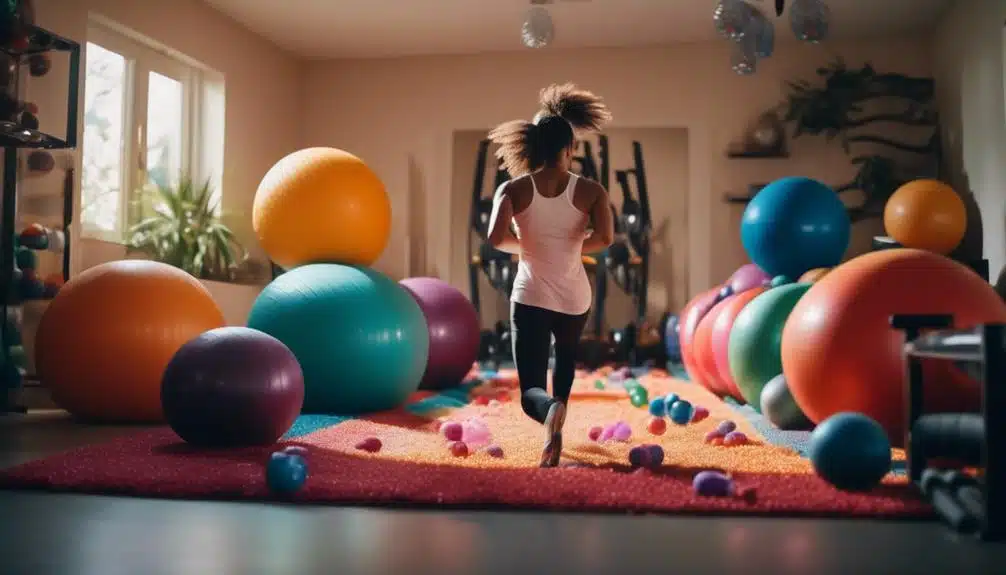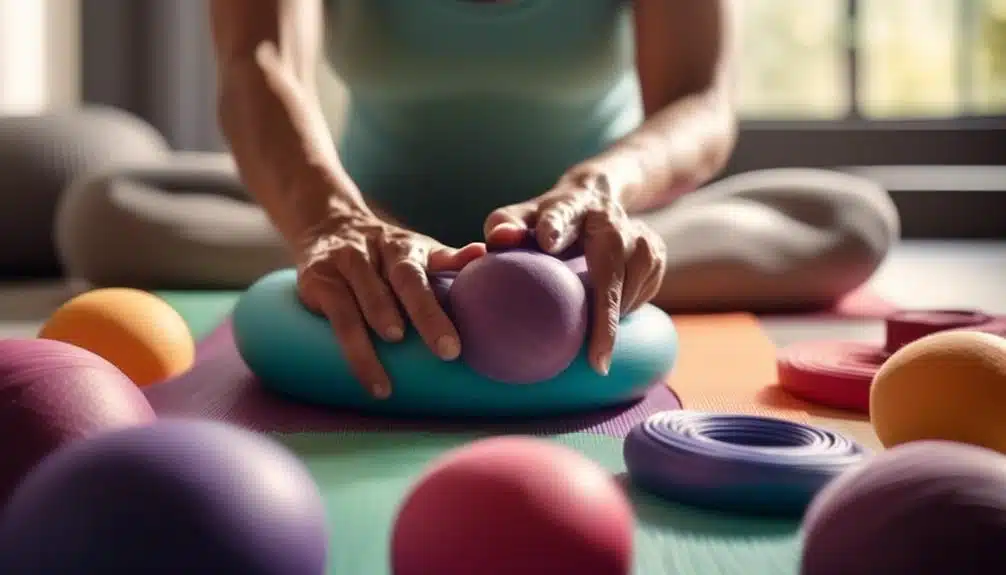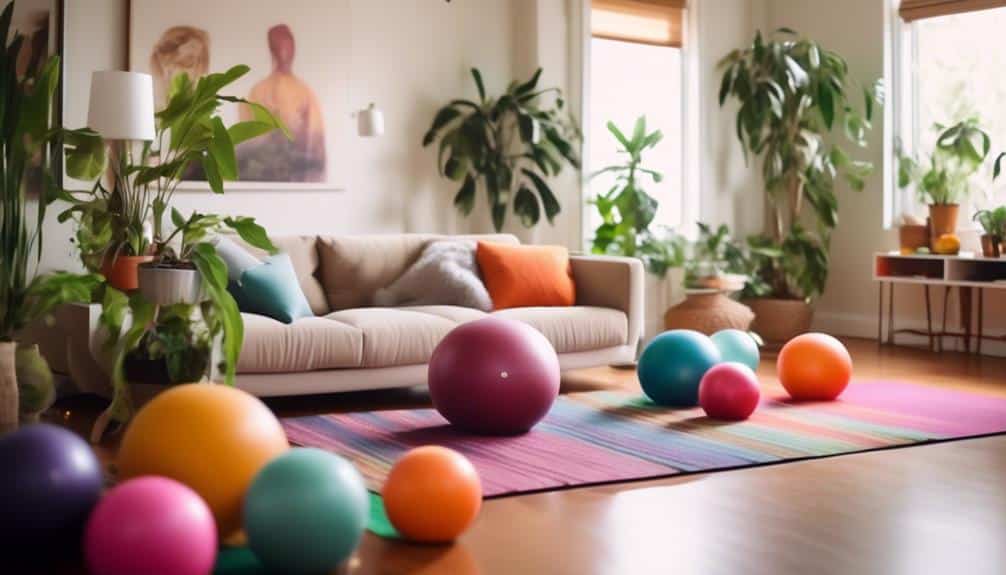In physical fitness, incorporating sensory-smart strategies into workouts for sensory with home workout routines offers a unique and beneficial approach for individuals with sensory processing differences, such as those with ADHD and Autism Spectrum Disorders. These specialized exercises not only target the improvement of physical health but also cater to the enhancement of sensory integration, which is paramount in managing the sensory challenges faced by these individuals. For instance, engaging in activities like resistance tunnel crawling or rhythmic jump rope sessions can significantly aid in refining motor skills and providing the necessary sensory feedback.
However, the effectiveness of these workouts and their potential to transform mundane routines into dynamic sensory experiences lies in the careful selection and execution of each activity. As we investigate these sensory-smart workouts further, one might ponder the breadth of outcomes they can produce in both sensory processing and overall well-being.
Key Takeaways
- Sensory integration and motor skills development activities, such as balancing beam challenges and sensory bin exploration, can enhance proprioception, improve coordination, and support motor skill development.
- Engaging in activities that build sensory integration, such as sensory integration and resistance tunnel crawling, can improve body awareness and sensory processing effectiveness and foster enhanced motor skills and body control.
- Rhythmic jump rope sessions and tactile sensory exploration activities, such as textured ball games, can enhance coordination, provide a multisensory experience, and promote the development of fine and gross motor skills.
- Group activities with textured balls and DIY obstacle courses can enhance social skills, support motor skills, develop hand-eye coordination, and relieve stress. Mindfulness benefits through multisensory stimulation and therapeutic dough manipulation.
Balancing Beam Challenges
Teetering on a balancing beam, individuals of all ages can harness the challenge to foster improved proprioception, enhance coordination, and support motor skills development. This simple yet effective activity engages the vestibular system, crucial for maintaining balance and spatial orientation. As participants navigate the narrow surface of a balancing beam, they receive valuable proprioceptive input, which helps refine body awareness and control.
Balancing beam challenges can be particularly beneficial for those with sensory processing difficulties. These activities offer a structured opportunity to integrate sensory input and practice motor planning. Individuals can build confidence and improve their sensory integration skills in a safe and controlled environment by gradually increasing the complexity of the tasks performed on the beam.
Furthermore, balancing beams can be easily adapted to cater to a wide range of skill levels, ensuring that everyone, from novices to seasoned practitioners, can engage meaningfully. Whether used as a therapeutic tool or a component of a dynamic home workout, balancing beam challenges are a versatile means of promoting sensory smarts through physical activity.
Sensory Bin Exploration
Building on the physical coordination developed through balancing beam activities, Sensory Bin Exploration offers a complementary avenue for enhancing sensory integration and cognitive growth through immersive, tactile experiences. As we delve into this hands-on activity, it becomes evident that sensory exploration is about fun and fostering a deep connection between the mind and body.
Here is how Sensory Bin Exploration can impact those we serve:
- Engages Multiple Senses: Diving hands-first into a bin filled with rice or beans stimulates touch, sight, and even sound, creating a symphony of sensory feedback.
- Promotes Cognitive Development: Searching for hidden objects amidst various textures encourages problem-solving and concentration, vital skills for learners of all ages.
- Customizable Experiences: By tailoring the bin contents, we cater to individual sensory needs, whether seeking a calming or stimulating encounter.
- Encourages Sensory Integration: Continuous interaction with different materials aids in developing a cohesive sensory system, which is crucial for everyday tasks.
This informed approach to sensory bin creation ensures that the experience is engaging, adaptive, and profoundly nurturing. By embedding a variety of textures within these bins, we lay the groundwork for a richer sensory exploration that resonates with the innate human desire to learn through touch and play.
Resistance Tunnel Crawling

Resistance tunnel crawling is an innovative exercise that contributes to sensory integration, offering substantial benefits for proprioception and muscle coordination. By incorporating this activity into a home workout routine, individuals can experience the advantages of enhanced body awareness, which is particularly crucial for those with sensory processing challenges. We will explore how to set up a DIY resistance tunnel and its positive impact on those with ADHD, Autism, and sensory sensitivities.
Building Sensory Integration
Crawling through a resistance tunnel offers essential deep pressure feedback, facilitating the integration of proprioceptive and vestibular senses, which is particularly beneficial for individuals with sensory processing challenges such as those encountered in Autism and ADHD. Engaging in this activity can significantly enhance one’s ability to process sensory information effectively, building sensory integration dynamically and interactively.
Consider these transformative benefits:
- Deep Pressure Input: Engages the body’s sensory receptors, promoting a calming effect.
- Proprioceptive Enhancement: Improves awareness of body position and movements.
- Vestibular Integration: Bolster’s balance and spatial orientation.
- Coordination and Body Awareness: Fosters improved motor skills and body control.
Resistance Tunnel Benefits
Reflecting on the dynamic nature of sensory integration, the practice of resistance tunnel crawling stands out for its distinctive ability to provide deep pressure input and improve proprioceptive feedback. This exercise is particularly beneficial for individuals with sensory needs, such as those with Autism and ADHD, offering a unique combination of fun and function.
| Benefit | Description |
|---|---|
| Deep Pressure Input | Enhances proprioceptive system functioning |
| Body Awareness | Increases coordination and spatial orientation |
| Sensory Integration | Encourages adaptive responses to tactile stimulation |
| Focus and Calmness | Promotes relaxation and concentration |
| Sensory Workout | It provides an enjoyable and stimulating physical challenge |
Resistance tunnel benefits are manifold, fostering a sense of calmness and aiding in developing vital sensory processing skills through engaging activities.
DIY Tunnel Setup
Constructing a makeshift resistance tunnel at home, using materials such as blankets and pillows, can provide a versatile and practical environment for engaging in resistance tunnel crawling exercises. This activity enhances physical fitness and enriches the sensory experience and hand-eye coordination, which are critical for individuals with sensory processing needs.
- Joyful Discovery: Watch the delight as loved ones navigate the tunnel, transforming a simple activity into a sensory adventure.
- Pride in Achievement: Celebrate each triumphant exit from the tunnel, recognizing the required effort and coordination.
- Sense of Connection: Share a bonding experience while guiding and encouraging through each crawl.
- Empowerment: Empower those with sensory challenges by providing a fun yet therapeutic exercise they can master and enjoy.
Rhythmic Jump Rope Sessions

Incorporating rhythmic jump rope sessions into a fitness regimen can significantly enhance coordination and motor skills, offering a multisensory experience that is both physically rewarding and beneficial for sensory integration. This exercise engages the entire body, intertwining a cardio workout with a sensory workout that can improve body awareness and coordination. The rhythmic motion of jumping to a beat and the tactile feedback from the rope create an environment where sensory processing is continuously challenged and honed.
To further enrich the sensory experience, adding music or rhythmic chants can transform a simple workout into a harmonious auditory and kinesthetic activity. This integration of sound helps individuals sync their movements with an external rhythm, fostering an even greater level of motor control and sensory input processing. Jump rope sessions can be easily tailored to different intensities, making it a versatile exercise option that can be adapted to meet the needs of those with varying sensory processing abilities.
Rhythmic jump rope workouts enhance sensory integration as an engaging and adaptive exercise. Encouraging participation in such activities can lead to improved physical health, heightened sensory awareness, and a joyous sense of accomplishment in individuals dedicated to serving others through fitness and well-being.
Textured Ball Games
Exploring the realm of textured ball games introduces a unique avenue for tactile sensory exploration, offering a playground that excites and educates the senses. These activities sharpen balance and coordination and encourage individuals to engage in dynamic drills that challenge their physical and sensory abilities. Moreover, textured ball games foster social interaction and collective sensory experiences when incorporated into interactive group activities, which is particularly beneficial for those with sensory processing differences.
Tactile Sensory Exploration
Delving into textured ball games opens up a world of tactile sensory exploration, offering a playful yet effective method to enhance sensory integration and motor skill development for individuals of all ages. These activities are particularly beneficial for individuals with Autism and ADHD, providing a valuable tool for engagement and learning.
- They provide a *sense of calm* and focus through repetitive tactile feedback.
- Textured balls stimulate the sense of touch, encouraging *sensory exploration* in a non-threatening way.
- Engaging with different textures can *reduce sensitivity* over time, fostering greater sensory adaptability.
- Playing with textured balls promotes *fine and gross motor skills* development, which is essential for daily activities.
Incorporating textured ball games into home workouts can be an enjoyable and nurturing way to support those we serve in their quest for sensory balance and motor proficiency.
Balance and Coordination Drills
Based on textured ball games’ tactile benefits, balance, and coordination drills further refine sensory integration and motor skills through structured play. These drills are an excellent way to stimulate the senses and improve physical abilities simultaneously. By incorporating textured balls, which provide diverse tactile input and sensory feedback, individuals, especially those with sensory processing challenges like ADHD and Autism, can experience a unique and beneficial workout.
The varied surfaces of textured balls demand greater proprioceptive engagement, which is crucial for developing precise motor skills. These balance and coordination drills encourage the body and brain to work harmoniously, enhancing overall sensory integration. This functional and inclusive exercise approach opens a pathway to improved well-being for people with diverse sensory needs.
Interactive Group Activities
Interactive group activities utilizing textured balls provide a dynamic environment for enhancing social skills and sensory-motor integration. Engaging in these activities, individuals with sensory processing needs find joy and stimulation that cater to their unique preferences. These textured ball games have been crafted to support the development of motor skills and hand-eye coordination, essential for the seemingly simple act of catching a ball.
Consider the following to evoke a deeper emotional connection:
- Witnessing the delight in a child’s eyes upon successfully catching a ball.
- Observing the growth in confidence as they master interactive group activities.
- I am feeling the sense of camaraderie that blossoms through cooperative play.
- I am sharing the triumph of each small victory in skill development.
These experiences are not just about play; they are building blocks for life.
DIY Obstacle Courses
Creating your obstacle course at home is a simple yet effective way to stimulate various sensory systems using items you likely already have around the house. Designing DIY obstacle courses allows you to craft a multifaceted workout routine that engages tactile, visual, and proprioceptive senses. This can be particularly beneficial for those seeking to serve others, such as caregivers or educators, who wish to incorporate sensory play into their activities.
Utilize everyday household objects to create pathways requiring participants to crawl under tables, balance cushions, or step over ropes. These actions promote motor skill development and spatial awareness, addressing the needs of diverse learners or family members. Each course element can be carefully chosen to enhance sensory engagement, ensuring a robust and dynamic experience.
Therapeutic Dough Manipulation

Therapeutic Dough Manipulation offers a unique multisensory approach to improving fine motor skills and alleviating stress, which is particularly beneficial for individuals with sensory processing disorders. This tactile exercise assists in coordination and muscle development and is a soothing activity that can help individuals feel more grounded and centered.
Here are some of the emotional benefits that come from engaging in this activity:
- Enhanced Calmness: The repetitive nature of kneading and shaping dough can induce a state of relaxation, similar to the effects of meditation.
- Joyful Discovery: The various textures and dough colors awaken a sense of curiosity and playfulness, often leading to smiles and laughter.
- Sense of Achievement: Completing a dough manipulation task can provide a satisfying sense of accomplishment, boosting self-esteem.
- Stress Relief: As hands work through the dough, the mind unwinds, providing a healthy outlet for releasing tension and anxiety.
Incorporating scented or colorful dough adds another layer to the sensory experience, stimulating the sense of smell and sight alongside touch. The activity promotes proprioceptive skills—essential for body awareness and control—and is adaptable, making it suitable for individuals with Autism, ADHD, or anyone looking to incorporate a therapeutic element into their sensory workout routine.
Vibratory Sensory Activities
Building on the foundation of tactile stimulation provided by therapeutic dough manipulation, vibratory sensory activities offer an alternative avenue for sensory input that can be especially advantageous for individuals with ADHD and Autism. These activities are designed to engage the proprioceptive and vestibular systems, critical in helping those on the Autism spectrum modulate sensory input and achieve a sense of balance and body awareness.
By incorporating movement-based exercises like swinging and playing catch, individuals can stimulate their senses while also partaking in beneficial physical activity. These dynamic activities promote coordination and motor skills and provide the necessary sensory feedback to improve focus and decrease anxiety.
Moreover, activities such as hiking or jogging with noise-canceling headphones can create a sensory experience that combines the benefits of cardiovascular exercise with controlled auditory input. This unique pairing can be particularly soothing for those with sensory processing challenges.
Additionally, integrating colorful weightlifting and yoga into a fitness routine can support sensory engagement and mindfulness, fostering an environment of calm and concentration. For more immersive sensory experiences, swimming, trampoline bouncing, body brushing, and navigating sensory paths can be exceptionally enriching for those on the Autism spectrum and individuals with ADHD, offering many options for vibratory sensory activities that cater to diverse needs and preferences.
Frequently Asked Questions
How Do You Do Workouts for Sensory Play at Home?
To conduct sensory play at home, create activities that stimulate the senses, such as tactile bins with different textures or auditory games with varying sounds, to engage and support sensory processing in a comfortable environment.
What Is a Sensory Diet for Adhd?
A sensory diet for ADHD is a tailored series of activities stimulating the senses to enhance focus, balance emotions, and improve body awareness, thus fostering an environment conducive to learning and personal growth.
What Are the Sensory Diet Activities?
Sensory diet activities include exercises like swinging, yoga, and swimming that provide essential sensory input, benefiting individuals with sensory processing challenges by enhancing focus, relaxation, and motor skills. Tailoring to individual needs is crucial.
How Do You Calm Sensory Seeking Behavior?
Seeking calm amidst sensory-seeking behavior? Integrating soothing activities such as deep pressure exercises, rhythmic rocking, or exposure to calming stimuli can significantly alleviate restlessness and promote a sense of tranquility in individuals.
Conclusion
If your child has sensory processing difficulties, incorporating sensory activities into their daily routine can help them manage their sensory input and improve their body awareness. Sensory processing disorder affects how a child’s sensory systems receive and respond to sensory input, leading to sensory issues that can affect their daily life. Occupational therapists suggest creating a sensory diet and a daily routine of sensory activities catering to the child’s sensory needs. These activities can include proprioceptive input, such as pushing against a wall, or tactile input, such as playing with cotton balls. Deep pressure input can also be helpful, such as using a stress ball or tennis balls.
Outdoor activities, such as playground swings and monkey bars, can provide vestibular input. In contrast, indoor activities, such as using an exercise ball or sitting on a chair with legs, can provide proprioceptive input. Sensory diet activities can be incorporated into a child’s daily routine, including during school. Break cards or weighted vests can provide deep-pressure input during classroom activities. Picture books and chewy or crunchy foods can provide auditory and oral motor input during breaks.
Incorporating sensory activities into a child’s routine can help them manage sensory overload and improve their sense of body awareness. Raising a Sensory Smart Child, a book by pediatric occupational therapists, provides sensory diet activities and strategies for parents and teachers to use with school-age kids with sensory processing issues. A ball pit or laundry baskets filled with pillows can provide deep pressure input, while joint compressions can help with body awareness.
Providing a child with a sensitive sensory system with a sensory diet can improve their social skills and help them cope with their sensory difficulties. With a stack of books or an office chair, the entire classroom can be transformed into a sensory-friendly environment that addresses the needs of mainstream classroom students.
In conclusion, incorporating sensory activities into a child’s daily routine can provide the necessary sensory input for their sensory processing needs. Parents and teachers can create a sensory diet that includes various sensory activities, such as messy play activities, to help children with sensory processing difficulties. By providing sensory breaks and activities, children can improve their sensory systems and manage their daily lives more quickly.


Recent Comments